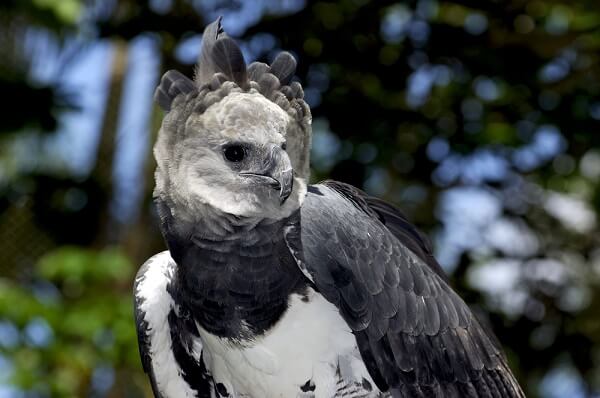
The harpy eagle is a large bird of prey endemic to many parts of Central and South America. Though the harpy eagle is nearing extinction in parts of Mexico, it is found throughout most countries of South America. Though the species has few predators, deforestation and the loss of natural habitats are causing decreases in harpy eagles throughout their range. Harpy eagles establish nests within the emergent layer of the canopy, where the sky can easily be accessed. Female harpies are slightly larger than the males and lay a clutch of two eggs every couple of years. However, two offspring have never been observed in the same nest, suggesting that the larger of the offspring eat the smaller in a phenomenon known as siblicide (killing one’s siblings). This may help the larger offspring survive to adulthood. The harpy eagle is an apex predator in its environment. While some reports have suggested that juvenile harpy eagles become prey for animals like jaguars, the harpy eagle has very few natural predators as an adult. Harpy eagles prey on many species throughout the jungle, but studies have shown that they prefer large mammals like sloths and monkeys that frequent the upper canopy of the rain forest. Since the harpy eagle is an extremely agile flyer, they can easily sneak up on capuchin monkeys and sloths that are browsing in the canopy. However, harpies also feed on parrots, iguanas, tegus, snakes, and over 100 other prey species! Harpy eagles may be one of the most ferocious predators of the jungle, but did you know that they can help explain several biological concepts? Let’s take a look at how harpy eagles can teach us about the rest of the animal kingdom! While humans have hunted many species to extinction directly, more species today are disappearing from the effects of indirect attacks. Of these, habitat destruction wreaks havoc on the highest number of species. For the harpy eagle, several aspects of habitat destruction have devastated populations. First and foremost, the harpy eagle needs large, sturdy trees to nest in. As trees like these are cut down to make lumber, clear space for agricultural endeavors, or removed for other reasons, harpy eagles simply cannot nest. Second, habitat destruction affects all of the species that the harpy eagle regularly preys upon. Monkeys and sloths rely on well-developed canopies to find ample amounts of food. Without them, populations of these prey species dwindle, and the harpy eagle cannot find enough food. As an apex predator of the jungle, harpy eagle populations can be drastically affected by any changes in their prey. Many other apex predators – from tigers to sharks – can serve as key indicators for the health of a population. Declines in apex predator populations are a key piece of evidence that habitat destruction is harming a natural environment. While it may seem morbid that harpy eagles lay two eggs but only ever raise one chick, this is actually fairly common in the animal kingdom. In general, survivorship for baby animals is much lower than that of an adult from the same species. This is because babies are weaker, more vulnerable to predation, and often have not developed the tools or size to defend themselves. To counter this, different species have come up with a large variety of adaptations. Some species release thousands of offspring at once, to increase the chances some will survive to adulthood. Other species, like humans and elephants, invest a large amount of parental care into offspring that increase their chances of surviving. In harpy eagles, the strategy appears to be siblicide. In fact, many predatory bird species, sharks, and other predators practice siblicide. Though a weaker offspring is lost, it provides nutrients and energy to the larger offspring. In some ovoviviparous sharks, the firstborn sharks feed on eggs and their smaller offspring within the mother until they can emerge at a size that they are more likely to survive. In the albatross, for instance, the smaller sibling is born several days after the first. Since the parents can spend days at sea hunting for migratory fish, the larger first offspring often eats its smaller, weaker sibling. This helps it survive until its parents return with a meal from the sea.
Kingdom
Animalia
Phylum
Chordata
Class
Aves
Order
Accipitriformes
Family
Accipitridae
Genus
Harpia
Species
Harpia harpyja
Niche
Apex Predator
Length
2-3.5 feet (86-107 cm)
Weight
9-20 lbs (4-9 kg)
Lifespan
Up to 35 years
Social Structure
Mated Pairs
Conservation Status
Near Threatened
Preferred Habitat
Tropical Forests of South America
Average Clutch Size
2 eggs, though typically only 1 offspring survives
Main Prey Species
Tree-Dwelling mammals, especially sloths and monkeys
Predators
Large cats, humans
The Basics

Interesting Insights from the Harpy Eagle!
Habitat Destruction

Siblicide

